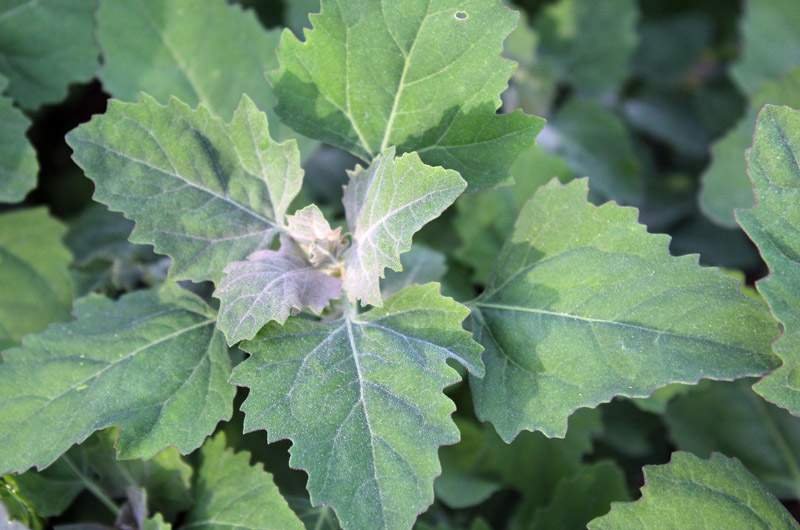Video by David Henry Gerson
The idea was to harvest lamb’s quarters before the Farmers’ Market on Saturday morning. There are sizable plants growing all over the dormant asparagus patch. That was the plan, but when the alarm sounded, and sleep lifted, it was clear that an immediate trip to Edgartown couldn’t be avoided and picking greens would have to wait. There was no traffic that early so the drive went fast. The errand also was completed quickly and in the end there was time to spare — not enough to get back to Beetlebung Farm, but the shorter trip to Mermaid Farm was doable and still beat the crowd at the market.
Caitlin Jones had garlic ready and filled the truck while the engine was still warm and, not surprisingly, she had clusters of the broad-leafed greens sprouting. We were about to set to it; then she spotted the toad hopping from a mud puddle, a reminder of the first rain in weeks. We knew time was short but spent a few minutes, then a few more, scrambling and splashing trying to corral the little guy. We failed but thoroughly enjoyed our unplanned exertions and even managed to fill a bag with her wild greens and fennel blossoms before leaving for the Ag Hall.
Lamb’s quarters, Chenopodium album, is a nutritious annual known by a slew of evocative nicknames — fat-hen, goosefoot, pigweed, bacon weed, dirty Dick weed, and Muck Hill weed are just a few. It flourishes in much of North America and is relished in parts of Asia. It is a weed, meaning a scrappy plant that can fend for itself — make its own way though it wasn’t invited. American gardeners have long fought a losing battle against these fast growers, which each produce about 70,000 seeds a year. It grows wild and widely and can be found in lots in Brooklyn and along roads in Los Angeles. Cut it and it comes back, but that is not a bad thing because it is arguably tastier than spinach and packed even more full of vitamins.
Spring lamb’s quarters are the most tender and succulent. The young leaves are delicious raw. Greens are, by and large, happier when it isn’t so hot and dry. Lamb’s quarters aren’t finicky though, and they will find a spot out of the direct sun and grow all summer — usually to about four feet though some report seeing plants as big as six feet tall. The leaves are covered with a powdery film. Summer plants can be leggy and woody so it is important to not only give them a good soaking but also discard the twiggy stem ends. The small branches you can let be, they will soften nicely when cooked, the best way to go at this time of year.
You can prepare lamb’s quarters as you would spinach or Swiss chard. Just adjust the cooking time according to the age and size of your cache. What did we do with ours? A little research revealed that in Korea, they sautee myeongaju, seasoning the greens with garlic, and soy and hot pepper pastes, and then finish the side dish with sesame seeds and oil. In Mexico, they like their quelites stewed with onions and chili and simmered in tomatillo sauce, or mixed with beans and used to fill tacos. Because we got ours from Mermaid Farm, and it’s been hot, we decided to make a cold soup and add yogurt. It was lovely and vibrant, nourishing and refreshing — we felt like we could taste the vitality of our recipe’s plucky namesake ingredient.
Recipe for Lamb Quarter Soup
Serves 4
It was already hot the morning we made this and we decided to get out cooking out of the way early. We started by poaching a couple of chicken breasts to serve cold. We simply put the breasts in a pot, covered them with water added salt and brought them to a simmer; then cooled them in the liquid. We used the broth to make the soup — which can be eaten either warm or chilled.
About 2 tablespoons olive oil
1 medium onion, peeled and diced
Kosher salt
2 medium cucumbers, peeled, seeded and diced
Pinch hot pepper flakes
About 3/4 pound lamb’s quarters, tough stems removed, roughly chopped (you want about 4 packed cups)
3 cups of chicken stock
1/4 cup yogurt
Heat the oil in a pot over medium heat. Add the onion, season with salt and cook, stirring occasionally until it softens, about 15 minutes. Add the cucumber and the pepper flakes and cook, stirring occasionally until the cucumber softens and becomes translucent, about 15 minutes. Add the lamb’s quarters and some more salt and cook, stirring frequently, until the greens are tender, about 10 minutes. Add the stock and bring to a boil. Let the soup simmer for a minute or two then pull the pot off the heat and allow the soup to cool for at least 10 minutes. Puree the soup in a blender or food processor. Stir in the yogurt, add additional salt if necessary then chill or heat and serve.
Chris Fischer is chef at The Covington restaurant in Edgartown. His 2015 Beetlebung Farm Cookbook won a James Beard award for American cooking. Catherine Young collaborates with him on writing and recipes.
Vide by David Henry Gerson; the fourth in a series of short videos about Beetlebung Farm.




Comments (1)
Comments
Comment policy »